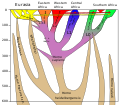File:Homo sapiens lineage.svg

原始檔案 (SVG 檔案,表面大小:722 × 632 像素,檔案大小:38 KB)
說明
說明
摘要
[編輯]| 描述Homo sapiens lineage.svg |
English: Simplified phylogeny of the species Homo sapiens (modern humans) for the last 600,000 years.
Based on Schlebusch et al., "Southern African ancient genomes estimate modern human divergence to 350,000 to 260,000 years ago" Science, 28 Sep 2017, DOI: 10.1126/science.aao6266 (preprint), Fig. 3: "Demographic model of African history and estimated divergences"[1]: Horizontal lines represent migration, with upward-pointing triangles representing admixture into another group. The six major divisions of modern humans are given as: Non-Africans (yellow), East Africans (orange), West Africans (red), Central African hunter-gatherers [African Pygmies] (blue), northern Khoi-San [NKSP] (green) and southern Khoi-San [SKSP] (green), mapped according to their broad historical distribution. Estimated split times given in the source cited (in kya): Human-Neanderthal: 530-690, Deep Human [H. sapiens]: 250-360, NKSP-SKSP: 150-190, Out of Africa (OOA): 70-120. For a caveat of these divergence times possibly being too early: see "Khoisan May Not Have Diverged ~300,000 Years Ago":
Note: evidence published since 2016 makes it less likely that H. heidelbergensis is the Neanderthal-sapiens-MRCA. Neanderthal-sapiens divergence is now more likely further back, between about 700 and 800 kya, H. heidelbergensis is entirely within the Neanderthal lineage, and the mrca is more likely (identical with or close to) H. antecessor. If these recent results are to be represented in the diagram, its scope will need to be extended to 800 kya. Literature:
---
|
| 日期 | |
| 來源 | 自己的作品 (sources used cited in description; see also: [2][3]) |
| 作者 | Dbachmann |
| 其他版本 |
|
授權條款
[編輯]- 您可以自由:
- 分享 – 複製、發佈和傳播本作品
- 重新修改 – 創作演繹作品
- 惟需遵照下列條件:
- 姓名標示 – 您必須指名出正確的製作者,和提供授權條款的連結,以及表示是否有對內容上做出變更。您可以用任何合理的方式來行動,但不得以任何方式表明授權條款是對您許可或是由您所使用。
- 相同方式分享 – 如果您利用本素材進行再混合、轉換或創作,您必須基於如同原先的相同或兼容的條款,來分布您的貢獻成品。
檔案歷史
點選日期/時間以檢視該時間的檔案版本。
| 日期/時間 | 縮圖 | 尺寸 | 用戶 | 備註 | |
|---|---|---|---|---|---|
| 目前 | 2018年4月26日 (四) 06:28 |  | 722 × 632(38 KB) | Dbachmann(對話 | 貢獻) | |
| 2018年1月14日 (日) 06:32 |  | 722 × 632(37 KB) | Dbachmann(對話 | 貢獻) | User created page with UploadWizard |
無法覆蓋此檔案。
檔案用途
下列20個頁面有用到此檔案:
- User:Achird/Hominidae
- User:Sobreira
- File:Hominini lineage.svg
- File:Hominoidea lineage.svg
- File:Homo lineage 2017update.svg
- File:Homo sapiens lineage.svg
- File:Human evolution chart-bg.svg
- File:Human evolution chart-el.svg
- File:Human evolution chart-en.svg
- File:Human evolution chart-fa.svg
- File:Human evolution chart-fr.svg
- File:Human evolution chart-he.svg
- File:Human evolution chart-hr.svg
- File:Human evolution chart-it.svg
- File:Human evolution chart-sv.svg
- File:Human evolution chart-tr.png
- File:Human evolution chart-tr.svg
- File:Human evolution chart-uk.svg
- File:Humanevolutionchart.svg
- Template:Other versions/Human evolution chart
全域檔案使用狀況
以下其他 wiki 使用了這個檔案:
- af.wikipedia.org 的使用狀況
- bn.wikipedia.org 的使用狀況
- cs.wikipedia.org 的使用狀況
- de.wikipedia.org 的使用狀況
- en.wikipedia.org 的使用狀況
- es.wikipedia.org 的使用狀況
- et.wikipedia.org 的使用狀況
- id.wikipedia.org 的使用狀況
- kk.wikipedia.org 的使用狀況
- lfn.wikipedia.org 的使用狀況
- pt.wikipedia.org 的使用狀況
- ru.wikipedia.org 的使用狀況
- sw.wikipedia.org 的使用狀況
- te.wikipedia.org 的使用狀況
- vi.wikipedia.org 的使用狀況
詮釋資料
此檔案中包含其他資訊,這些資訊可能是由數位相機或掃描器在建立或數位化過程中所新增的。若檔案自原始狀態已被修改,一些詳細資料可能無法完整反映出已修改的檔案。
| 寬度 | 721.97736 |
|---|---|
| 高度 | 632.32526 |




